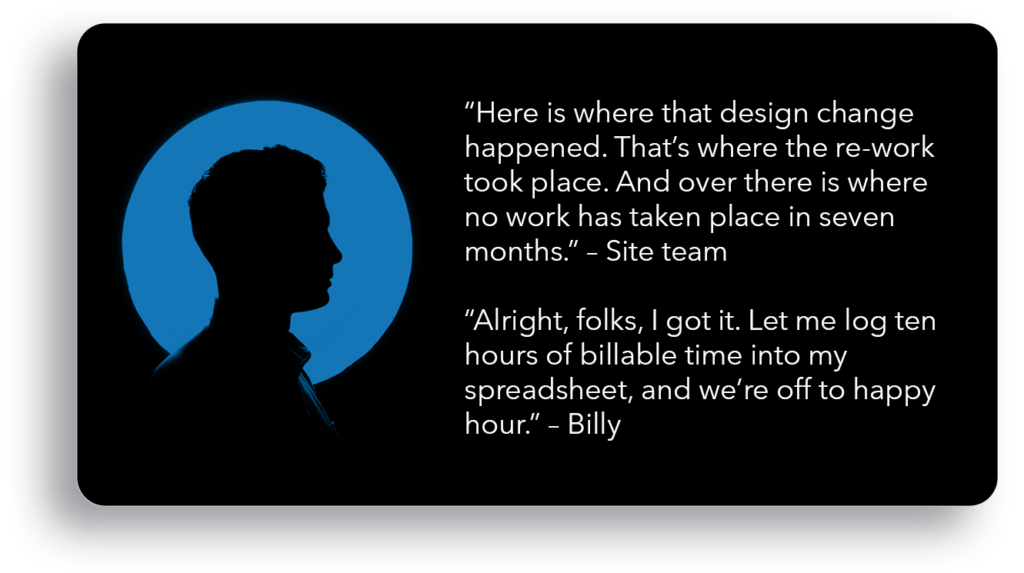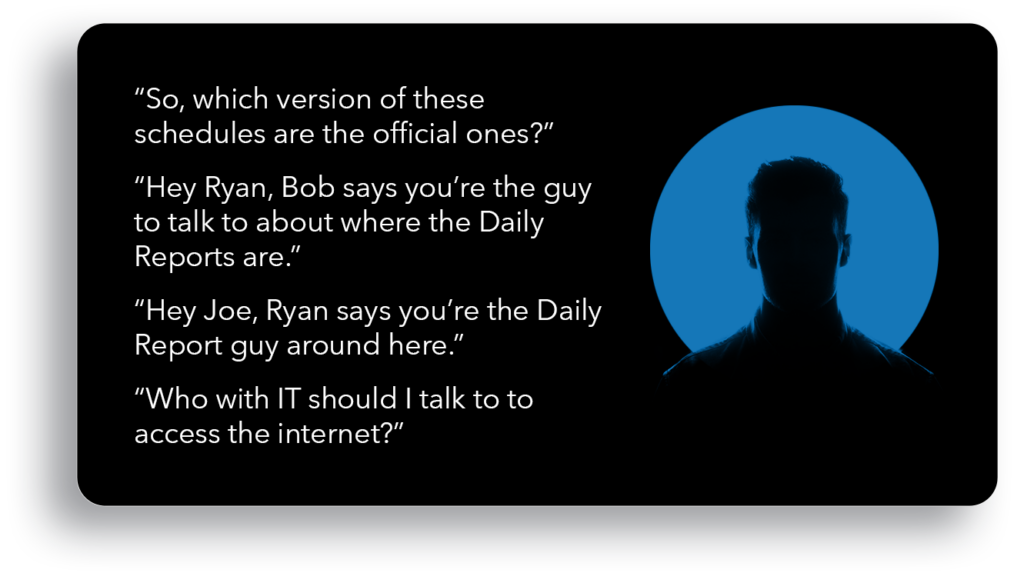Making sense of all of your data from all of your projects can feel like trying to understand a foreign language. But, when we break it down into steps, it starts to make a lot more sense.

- News
Confessions of a Former Construction Delay Consultant
It was winter 2009, and my flip phone started ringing. It was my grandfather with news that would change my life forever. He had a former colleague working at an upstart construction delay consulting firm, and the firm was looking for junior staff to help out. Seeing as though I was still on the fence about law school, I decided to take the internship for my last semester of college to dip my toes into the construction delay consultant world.
The next thing I knew, ten years had flown by. By then, I had traveled to the four corners of our planet, sat in an untold number of site trailers on all types of projects imaginable, and worked with every kind of character our industry offers. Nevertheless, I decided to walk away from the construction delay consulting world with a single, straightforward takeaway.
My bosses made a ton of money because their clients did not stay on top of their schedules and documentation.
Before I go any further, I do not want this blog taken as a personal attack aimed at my former clients or colleagues–no finger-pointing happening here! Still, I feel there is a need for a broader discussion on the emerging abilities of lean site teams to avoid the pitfalls of poor data management that lead to engagement in the claims process.
To start that discussion, I intend to objectively lay out a representative timeline from my experience as a junior delay consultant to show how quickly the dreaded billable hour can rack up during the claims process. The goal is for you, the reader, to walk a day in my shoes (scary, I know) to reveal commonalities I found with the litany of projects that required my service.
The Early Days of Construction Delay Consultancy
So, let’s set the table. What were my roles and responsibilities in the first 45 days of an engagement? As a junior consultant, my part was that of the “grunt” – the person handling the dirty work. Effectively. I was responsible for understanding our challenges, organizing the chaos, and providing a well-defined analysis for my boss to act upon.
My role revolved around two main aspects of the project:
- Schedule update reviews and validation, and,
- Contemporaneous documentation gathering and processing to produce a correct, defendable as-built schedule.
Basically, my job as the delay consultant was to know how accurate the project’s perceived story was and make the proper adjustments based on the universe of project data available.
And so I went: the call came into my firm, and I was on the next flight out…
Day 1: Meeting the Site Team
After flying into my destination city, the next step was to rent a car to venture out to the site. Strangely enough, I rarely found myself assigned to projects in city centers, which added a touch of excitement to the process of selecting hotels.
Upon arrival, it was time for orientation. I shook hands with the site team I would be collaborating with, engaging in the usual pleasantries–like discussing why the Baltimore Orioles were having such a tough year.
Next came lunchtime, where I was chauffeured off to the local lunch spot and advised to avoid getting the fish. At this point, we delved deeper into the project, and I received raw takes from each person actively involved. Everyone had their own cause de jour, but I nodded my head–and a salt shaker–to absorb the vibes.
After lunch, there remained enough time for a site walk. This tour offered me a glimpse of the scenes of the crimes:

Day 2: The Real Work
On the second day, the real work began, and I held meetings with key team members to understand the engagement’s goals. The questions started flowing.
“What do we think we’re owed? Why do we think we’re owed it? What attempts have been made so far to recoup our losses? What are the expectations of the client’s upper management? …Wouldn’t this meeting be much quicker if we locked the trailer doors?”
Lunchtime rolled around once more. This time, we headed to the second spot in the rotation, where the fastball was about eight miles slower than the day before. The club sandwich and fries combo was the only safe bet for a satisfying meal.
Once we returned to the site, it was time for what I came for–the schedules and the documents. I posed the dreaded question every consultant asks, “What documents do you have, and where are they?”
The answer to that seemingly innocuous question would set the tone for the rest of the engagement. Some sites have boasted excellent document control practices and promptly handed over a hard drive with all the data my analytical heart desired. Unfortunately, most of the time, the response began with, “Oh man. I think there…”
The rest of my day turned into a scavenger hunt. I approached anyone wearing a hard hat, but nobody wanted to make eye contact. The project was still active and delayed, leaving everyone stressed and not necessarily wanting to deal with “The Delay Consultant.”

When it was time to head back to the Hilton Garden Inn, a few things became clear.
- This project has been ongoing for 22 months, with a monthly schedule update cadence, and I had 63 schedule updates, one of which ended with “rev. 5–alternate sub schedule.”
- The daily reports were tucked away in a filing cabinet.
- The RFI, Submittal, Change Order, and Design Drawing logs needed “cleaning up,” but the backup documentation file names were not discernible.
- And, as with all other jobs, the photos were pretty well organized.
- However, to my dismay, this hotel didn’t get NFL Network!? (Keep in mind, this was well before streaming services.)
Day 3: Finalizing the Document Wish List
I was back on site around 0900, and it felt like everyone had never left after I departed. By now, I had carved out my own little space on a corner of a folding table to call my own. On day three, the site team needed to attend to the “real” work they had neglected for the past 48 hours, so I quietly booted up my laptop and stared disappointingly into my grab-n-go hotel breakfast.
This morning’s goal was to finalize a wishlist of documents to hand over before my evening flight. I spent most of the uneventful day grinding through documents, trying to figure out what I might be missing or what I hadn’t realized I needed. This was my best chance to get my hands on anything and everything, as it might require another trip out here to retrieve any missed documents. I didn’t limit myself to finding:
- Schedules
- Daily Reports
- Photos
- Emails
- Meeting Minutes
- RFIs
- Change Orders
- Submittals
- Pay Apps
I got my document wish list as finalized as possible, passed it along to the team, and soon found myself at a bar, inside an IHOP, inside an airport.
Days 4-14: Gathering the Data
During this period, my focus was on three primary tasks:
- Waiting for the balance of my documents,
- Digging into the schedule updates to figure out which ones should serve as schedules of record,
- Organizing the other contemporaneous documentation and putting a game plan in place.
It was crucial not to get ahead of myself until I had all the data available. Consequently, this phase was usually the least productive part of any engagement. The last thing I wanted was to venture down a rabbit hole only to find that newly discovered data contradicted my work. At least, that’s what I convinced myself of.
Days 15-45: Validating the Schedule
The grind hit full effect during this phase. Days 15-45 were why I invested in high-quality headphones and had a podcast subscription list in the double digits.
By this point, I should have received a link from the client with all the documentation I requested, although some file formats could have been more conducive to analysis. At this stage, my singular goal was to process the data into something usable, meaningful, defendable, and reflective of an accurate project description. This process involved two phases.
1. Schedule Data
During this phase, I reviewed key schedules for quality, validating critical paths and planned sequences, and scrutinizing progress reporting accuracy–which involved the following series of investigations:
- Was the baseline schedule built according to industry standards (i.e., the DCMA Methodology)? If not, where are the flaws, and what are our options for healing the schedule?
- Did we maintain quality schedules throughout the lifecycle of the project?
- Can we “defend” the critical path objectively? Considering the changes that affect the critical path, what are the riskiest changes?
- Were the durations and sequencing in the schedule reasonable? Why were there adjustments from update to update? Should those updates have been part of the baseline? What changes could qualify as manipulation, changes to the scope, or better accuracy, given actual progress thus far?
2. As-Built Validation
The next part was when I delved into what the other side might think of our narrative by diving into schedule comparisons, questioning abnormalities in progress reporting such as actual date changes, percent complete decreases, activity additions and deletions, etc.
Then, I meticulously combed through contemporaneous documentation, organizing it into a usable database to ensure an accurate as-built schedule. This effort consumed time and caused the client’s bill to rise. I spent weeks logging handwritten daily reports, meeting minutes, email chains, RFIs, etc., into an Excel spreadsheet. Why? Because it turned out that the as-built data in the schedules was unreliable and required validation and correction.
As my off-site investigation wrapped up, it became time for at least one more trip to the site for an in-person working session.
Unraveling the Costly Puzzle: Efficient Strategies to Avoid the Junior Delay Consultant’s Grind
All of these experiences led me to the impetus for this blog. How can you avoid the expenses of a junior delay consultant’s grind? How can you prevent a 20-something-year-old with a hefty $250-per-hour price tag (not to mention the boss’s premium billable hour charge) from appearing at your project site just to organize schedules? After all, in the example above, that junior delay consultant just cost your project in the neighborhood of $90,000 for nine weeks of work.
With so many moving parts on a project, there’s one thing you can do that I can promise will take care of 80% of the machinations described above. Invest in your scheduling practices.
The schedule is your first and best line of defense and offense. For whatever reason, scheduling is often viewed as a defensive posturing measure. However, a well-kept schedule can also be your best offensive playbook when requesting time extensions and finding efficiencies in project execution.
- Begin with emphasizing schedule quality from the get-go and give incentives to maintain that quality because having an accurate and defendable schedule is everything.
- Next, update the schedule at least every 2-weeks as a quicker update cadence prevents knowledge loss on actual progress data.
You know the old cliche, “I can’t even remember what I had for dinner last night.” Now, imagine trying to recall the 4th-floor-rough-in that was completed four weeks ago. With this in mind, updating the schedule more frequently lets you catch critical path delays quicker and devise suitable solutions.
Having a schedule that is never more than fourteen days out of date also adds greater validity and utility as a planning tool. In the fast-paced world of construction projects, any plan older than 14 days becomes obsolete. Moreover, with fewer changes to keep track of, these updates become more defendable. (For those aiming to go above and beyond, you get bonus points for updating the schedule on a weekly basis.)
Final Thoughts from the Former Delay Consultant
In the construction industry, there’s often a misconception that project teams are solely to blame for the lack of schedule and document control. However, it’s essential to recognize the challenges they face.
Due to competitive bidding and limited managerial bandwidth, some project teams often find it challenging to focus on any scheduling recommendations, assuming they won’t have the time to utilize the findings in a meaningful way. So, why bother?
But here’s the exciting part–incredible tools like SmartPM are now available to instantly add value, avoid claims, and improve the bottom line. Embracing these solutions can create a more efficient and successful project environment–so you can avoid the confessions of delay consultants.
RELATED STORIES

Making Construction Data Analytics Easier to Understand
Making sense of all of your data from all of your projects can feel like trying to understand a foreign language. But, when we break it down into steps, it starts to make a lot more sense.

Overcoming Confirmation Bias in Construction Project Management
Confirmation bias can be particularly problematic in project and schedule management, where decisions must be based on accurate and comprehensive information.

Top Construction Scheduling Software in 2023
SmartPM’s recognition as a top construction scheduling software in 2023 attests to the immense value in automated project controls.

Putting the ‘Smart’ in Project Management with Project Controls
Project controls are not just a subset of project management; they are its backbone, focusing on meticulous monitoring and analysis.

